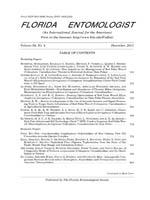Efforts to investigate the vertical dimension of forests continue to refine our thinking on issues of biodiversity and ecology. Arthropod communities exhibit a high degree of vertical stratification in forests worldwide but the vertical distribution patterns of most taxa remain largely unexplored or poorly understood. For example, only 2 studies provide information on the vertical distribution patterns of predatory wasps in temperate deciduous forests. In Canada, Vance et al. (2007) found Sphecidae to be more abundant in flight intercept traps suspended 18 m or more above the ground than in traps suspended near ground level. Similarly, in Germany, Sobek et al. (2009) found Sphecidae and Vespidae (Eumeninae) to produce more brood cells in artificial cavities placed in tree crowns than in those placed near the forest floor.
Nothing is currently known about how social predatory wasps in the subfamilies Vespinae and Polistinae are distributed within forest canopies. This is unfortunate considering the ecological significance of these large and highly mobile insects. For instance, social vespids represent one of the principal mortality factors for caterpillars in many habitats (Morris 1972; Steward et al. 1988; Lichtenberg & Lichtenberg 2003). In an Arkansas forest, for example, Steward et al. (1988) found Vespula maculifrons (Buysson) and V. squamosa (Drury) to be the most important predators of Heliothis virescens (Fabricius) larvae, removing over 90% of those placed 1.8–2.5 m above the ground. Similarly, Polistes fuscatus Fabricius and P. dominulus Christ removed 77–99% of Hemileuca lucina Hy. Edwards placed in a Massachusetts garden (Stamp & Bowers 1988). This intense predation pressure is known to have immediate effects on caterpillar behavior (Stamp & Bowers 1988) and may select for certain life history traits as well. For example, by preferentially preying upon caterpillars with a wide host range (presumably because they are more palatable), vespids may act to increase host-plant specificity over evolutionary time (Richter 2000, and references therein).
The objectives of this paper are to 1) present results on the vertical distribution and seasonality of Vespidae from a southeastern U.S. temperate deciduous forest and 2) propose that these predators may influence voltinism (number of generations) in some lepidopteran species.
Vespidae were sampled at two heights as part of a larger study on the vertical distribution of insects in a temperate deciduous forest. Detailed methodology and results for beetles and bees can be found in Ulyshen & Hanula (2007) and Ulyshen et al. (2010), respectively. Briefly, 12 dominant overstory trees were selected in a mature bottomland forest within the Oconee National Forest in Oglethorpe County, Georgia. Each tree had 1 flight intercept trap suspended in the canopy (≥15 m) and one suspended near ground level (0.5 m). The traps, consisting of intersecting clear plastic vanes attached to white buckets, were operated continuously for most of the growing season, from 5 Apr to 28 Jun and from 12 Jul to 4 Oct 2005. Samples were collected every 2 weeks.
In total, 522 vespids were collected representing 8 species (Table 1). Vespula maculifrons (Buysson) dominated the samples (83%) followed by Dolichovespula maculata (Linnaeus) (8%) and Vespula squamosa (Drury) (4%). Almost all specimens (99%) were captured in the upper traps. Vespid abundance increased dramatically in mid season, peaking in late Jul and early Aug (Fig. 1).
These results show that vespids, including the ground-nesting Vespula, are much more active in the canopy than near the ground. These patterns likely reflect the greater availability of prey (especially caterpillars) and carbohydrate sources such as honeydew and sap in the canopy, although the availability of plant fibers, water and nesting locations may also be important (Richter 2000; Vance et al. 2007; Sobek et al. 2009; Ulyshen 2011). In addition, some vespids are known to circle high above feeding sites when returning to their nests, presumably for orientation purposes (Richter 2000).
The striking mid-season increase in vespid abundance (Fig. 1), an observation consistent with previous studies (Spradbery 1971; MacDonald & Matthews 1981), is particularly interesting. Considering this seasonal pattern and the extremely high predation rates documented elsewhere (Stewart et al. 1988; Stamp & Bowers 1988), we speculate that vespids may play a previously unrecognized role in determining voltinism (i.e., the number of generations) in Lepidoptera. Many lepidopteran species in temperate deciduous forests are univoltine, producing only a single generation a year and focusing their larval feeding activities on early spring foliage. This pattern has traditionally been attributed to the well-documented seasonal decline in host-plant quality (Schaefer 1991). For some species, however, it could also represent a response to the coincident increase in vespid predation pressure.
TABLE 1.
LIFE HISTORY INFORMATION AND MEAN ± SE (N = 12) ABUNDANCE OF VESPID SPECIES CAPTURED IN FLIGHT INTERCEPT TRAPS SUSPENDED IN THE CROWNS (≥ 15 M) OR NEAR THE BASES (0.5 M) OF TREES IN A TEMPERATE DECIDUOUS FOREST.

Fig. 1.
Mean ± SE (re = 12) number of vespid wasps captured at twelve locations (canopy and ground traps combined) in a temperate deciduous forest.

We further speculate that caterpillars exposed to these high mid-seasonal wasp populations may exhibit a greater incidence of defensive behaviors or morphological characteristics than univoltine species or early-season conspecifics. This might include nighttime foraging (Fitzgerald et al. 1988), sequestration of host defense compounds (Camara 1997) or spines (Murphy et al. 2010). Future research addressing these questions would be of considerable interest.
SUMMARY
Flight intercept traps suspended in the crowns (≥15 m) and near the bases (0.5 m) of 12 trees in a temperate deciduous forest yielded 522 vespid wasps. The most common species were Vespula maculifrons (Buysson), Dolichovespula maculata (Linnaeus) and Vespula squamosa (Drury). Almost all specimens (99%) were captured in the upper traps. Vespid abundance increased dramatically in mid season, peaking in late Jul and early Aug. The possible importance of these predators in determining lepidopteran voltinism is discussed.





